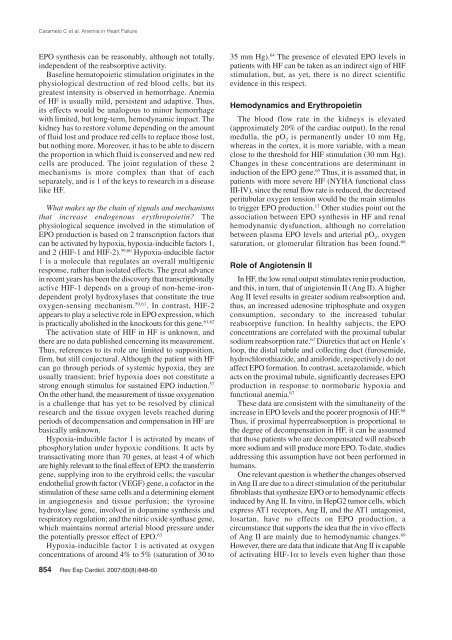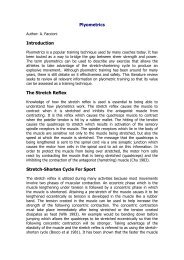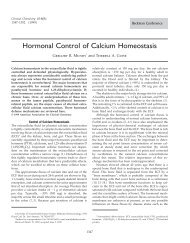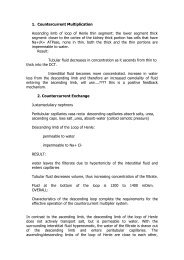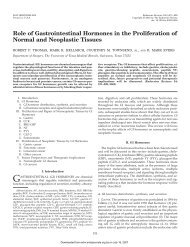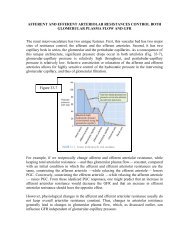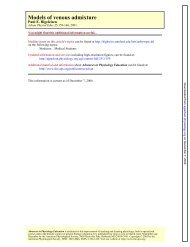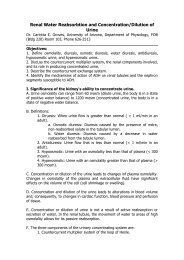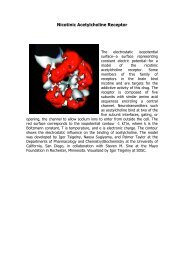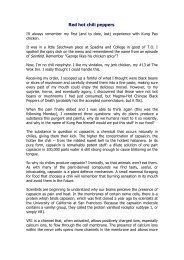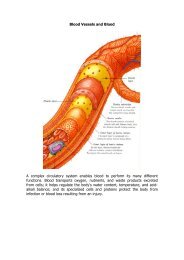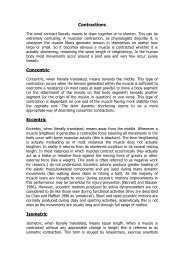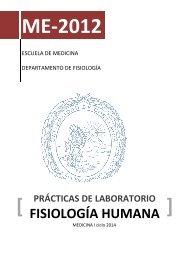Anemia in Heart Failure: Pathophysiology, Pathogenesis, Treatment ...
Anemia in Heart Failure: Pathophysiology, Pathogenesis, Treatment ...
Anemia in Heart Failure: Pathophysiology, Pathogenesis, Treatment ...
You also want an ePaper? Increase the reach of your titles
YUMPU automatically turns print PDFs into web optimized ePapers that Google loves.
Caramelo C et al. <strong>Anemia</strong> <strong>in</strong> <strong>Heart</strong> <strong>Failure</strong>EPO synthesis can be reasonably, although not totally,<strong>in</strong>dependent of the reabsorptive activity.Basel<strong>in</strong>e hematopoietic stimulation orig<strong>in</strong>ates <strong>in</strong> thephysiological destruction of red blood cells, but itsgreatest <strong>in</strong>tensity is observed <strong>in</strong> hemorrhage. <strong>Anemia</strong>of HF is usually mild, persistent and adaptive. Thus,its effects would be analogous to m<strong>in</strong>or hemorrhagewith limited, but long-term, hemodynamic impact. Thekidney has to restore volume depend<strong>in</strong>g on the amountof fluid lost and produce red cells to replace those lost,but noth<strong>in</strong>g more. Moreover, it has to be able to discernthe proportion <strong>in</strong> which fluid is conserved and new redcells are produced. The jo<strong>in</strong>t regulation of these 2mechanisms is more complex than that of eachseparately, and is 1 of the keys to research <strong>in</strong> a diseaselike HF.What makes up the cha<strong>in</strong> of signals and mechanismsthat <strong>in</strong>crease endogenous erythropoiet<strong>in</strong>? Thephysiological sequence <strong>in</strong>volved <strong>in</strong> the stimulation ofEPO production is based on 2 transcription factors thatcan be activated by hypoxia, hypoxia-<strong>in</strong>ducible factors 1,and 2 (HIF-1 and HIF-2). 59,60 Hypoxia-<strong>in</strong>ducible factor1 is a molecule that regulates an overall multigenicresponse, rather than isolated effects. The great advance<strong>in</strong> recent years has been the discovery that transcriptionallyactive HIF-1 depends on a group of non-heme-irondependentprolyl hydroxylases that constitute the trueoxygen-sens<strong>in</strong>g mechanism. 59,61 . In contrast, HIF-2appears to play a selective role <strong>in</strong> EPO expression, whichis practically abolished <strong>in</strong> the knockouts for this gene. 61,62The activation state of HIF <strong>in</strong> HF is unknown, andthere are no data published concern<strong>in</strong>g its measurement.Thus, references to its role are limited to supposition,firm, but still conjectural. Although the patient with HFcan go through periods of systemic hypoxia, they areusually transient; brief hypoxia does not constitute astrong enough stimulus for susta<strong>in</strong>ed EPO <strong>in</strong>duction. 57On the other hand, the measurement of tissue oxygenationis a challenge that has yet to be resolved by cl<strong>in</strong>icalresearch and the tissue oxygen levels reached dur<strong>in</strong>gperiods of decompensation and compensation <strong>in</strong> HF arebasically unknown.Hypoxia-<strong>in</strong>ducible factor 1 is activated by means ofphosphorylation under hypoxic conditions. It acts bytransactivat<strong>in</strong>g more than 70 genes, at least 4 of whichare highly relevant to the f<strong>in</strong>al effect of EPO: the transferr<strong>in</strong>gene, supply<strong>in</strong>g iron to the erythroid cells; the vascularendothelial growth factor (VEGF) gene, a cofactor <strong>in</strong> thestimulation of these same cells and a determ<strong>in</strong><strong>in</strong>g element<strong>in</strong> angiogenesis and tissue perfusion; the tyros<strong>in</strong>ehydroxylase gene, <strong>in</strong>volved <strong>in</strong> dopam<strong>in</strong>e synthesis andrespiratory regulation; and the nitric oxide synthase gene,which ma<strong>in</strong>ta<strong>in</strong>s normal arterial blood pressure underthe potentially pressor effect of EPO. 63Hypoxia-<strong>in</strong>ducible factor 1 is activated at oxygenconcentrations of around 4% to 5% (saturation of 30 to35 mm Hg). 64 The presence of elevated EPO levels <strong>in</strong>patients with HF can be taken as an <strong>in</strong>direct sign of HIFstimulation, but, as yet, there is no direct scientificevidence <strong>in</strong> this respect.Hemodynamics and Erythropoiet<strong>in</strong>The blood flow rate <strong>in</strong> the kidneys is elevated(approximately 20% of the cardiac output). In the renalmedulla, the pO 2is permanently under 10 mm Hg,whereas <strong>in</strong> the cortex, it is more variable, with a meanclose to the threshold for HIF stimulation (30 mm Hg).Changes <strong>in</strong> these concentrations are determ<strong>in</strong>ant <strong>in</strong><strong>in</strong>duction of the EPO gene. 65 Thus, it is assumed that, <strong>in</strong>patients with more severe HF (NYHA functional classIII-IV), s<strong>in</strong>ce the renal flow rate is reduced, the decreasedperitubular oxygen tension would be the ma<strong>in</strong> stimulusto trigger EPO production. 17 Other studies po<strong>in</strong>t out theassociation between EPO synthesis <strong>in</strong> HF and renalhemodynamic dysfunction, although no correlationbetween plasma EPO levels and arterial pO 2, oxygensaturation, or glomerular filtration has been found. 66Role of Angiotens<strong>in</strong> IIIn HF, the low renal output stimulates ren<strong>in</strong> production,and this, <strong>in</strong> turn, that of angiotens<strong>in</strong> II (Ang II). A higherAng II level results <strong>in</strong> greater sodium reabsorption and,thus, an <strong>in</strong>creased adenos<strong>in</strong>e triphosphate and oxygenconsumption, secondary to the <strong>in</strong>creased tubularreabsorptive function. In healthy subjects, the EPOconcentrations are correlated with the proximal tubularsodium reabsorption rate. 67 Diuretics that act on Henle’sloop, the distal tubule and collect<strong>in</strong>g duct (furosemide,hydrochlorothiazide, and amiloride, respectively) do notaffect EPO formation. In contrast, acetazolamide, whichacts on the proximal tubule, significantly decreases EPOproduction <strong>in</strong> response to normobaric hypoxia andfunctional anemia. 67These data are consistent with the simultaneity of the<strong>in</strong>crease <strong>in</strong> EPO levels and the poorer prognosis of HF. 68Thus, if proximal hyperreabsorption is proportional tothe degree of decompensation <strong>in</strong> HF, it can be assumedthat those patients who are decompensated will reabsorbmore sodium and will produce more EPO. To date, studiesaddress<strong>in</strong>g this assumption have not been performed <strong>in</strong>humans.One relevant question is whether the changes observed<strong>in</strong> Ang II are due to a direct stimulation of the peritubularfibroblasts that synthesize EPO or to hemodynamic effects<strong>in</strong>duced by Ang II. In vitro, <strong>in</strong> HepG2 tumor cells, whichexpress AT1 receptors, Ang II, and the AT1 antagonist,losartan, have no effects on EPO production, acircumstance that supports the idea that the <strong>in</strong> vivo effectsof Ang II are ma<strong>in</strong>ly due to hemodynamic changes. 69However, there are data that <strong>in</strong>dicate that Ang II is capableof activat<strong>in</strong>g HIF-1α to levels even higher than those854 Rev Esp Cardiol. 2007;60(8):848-60


